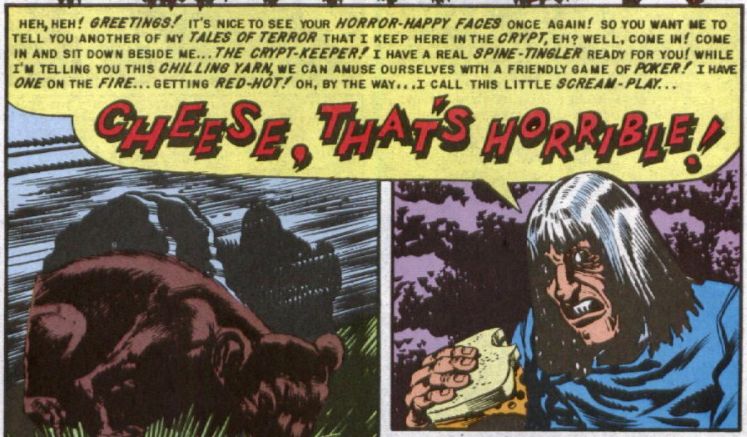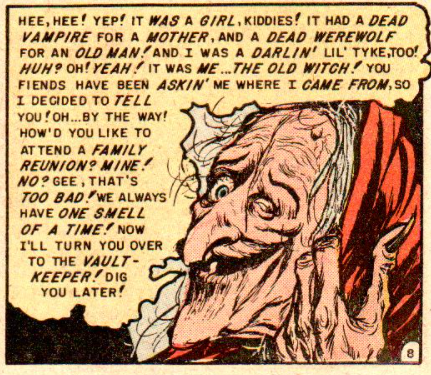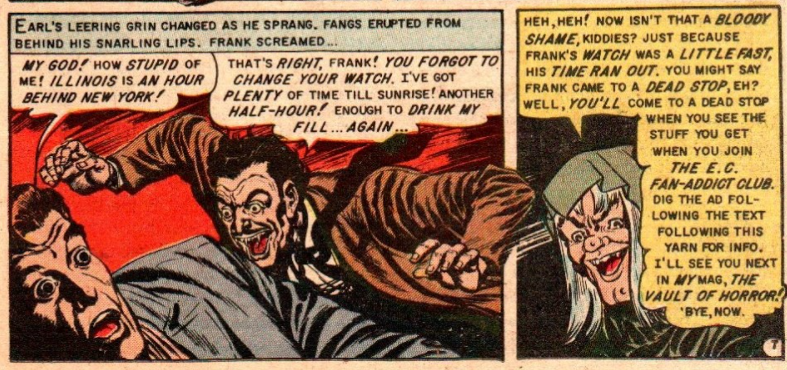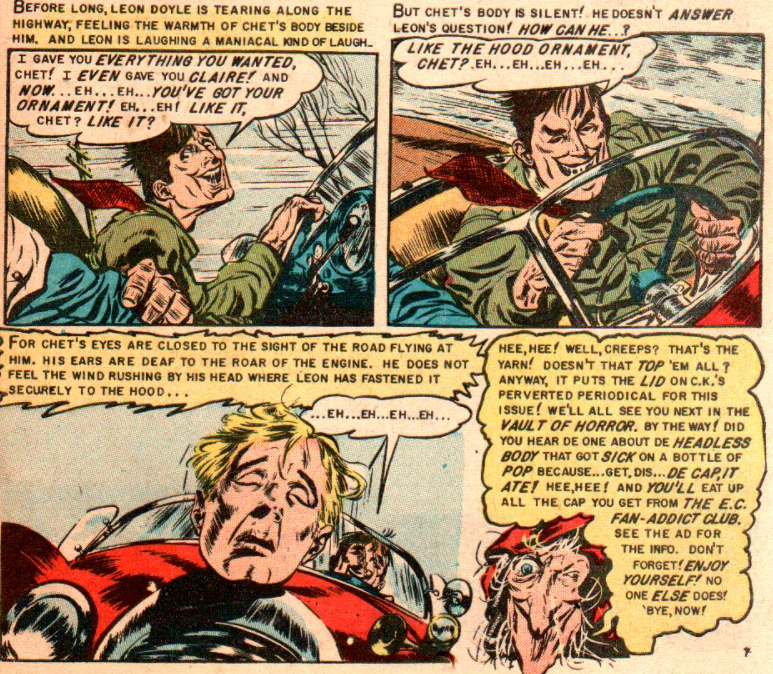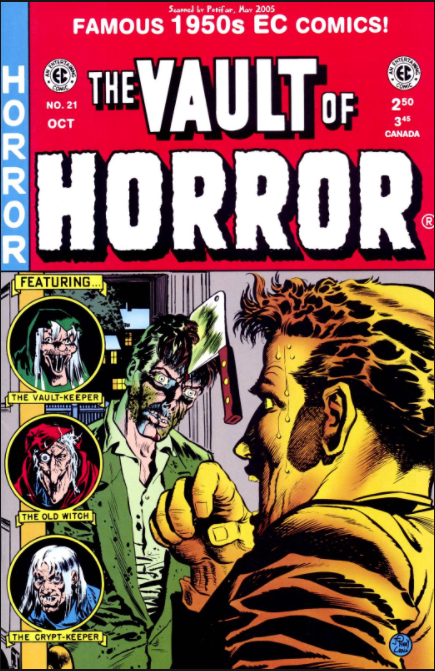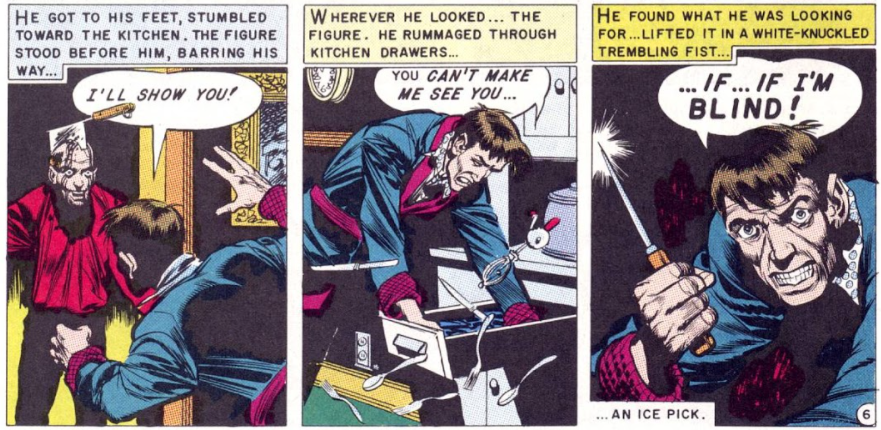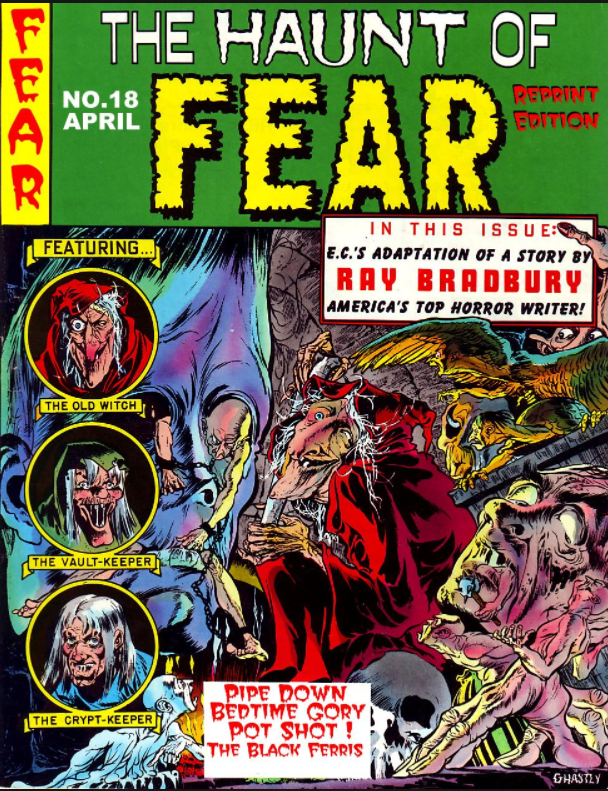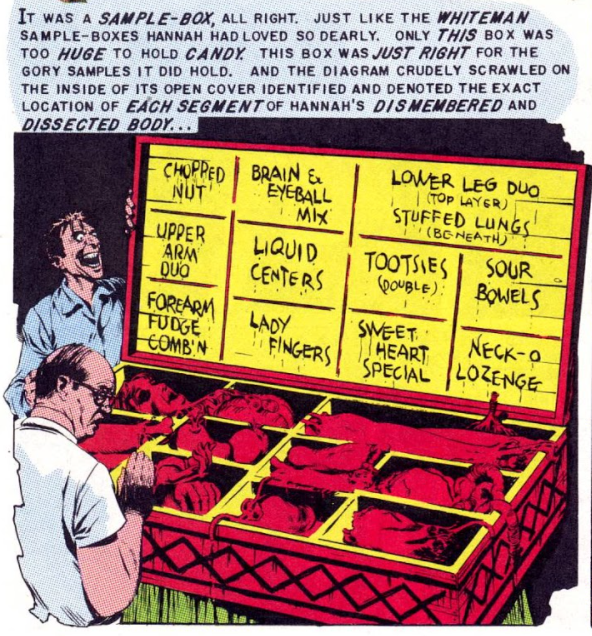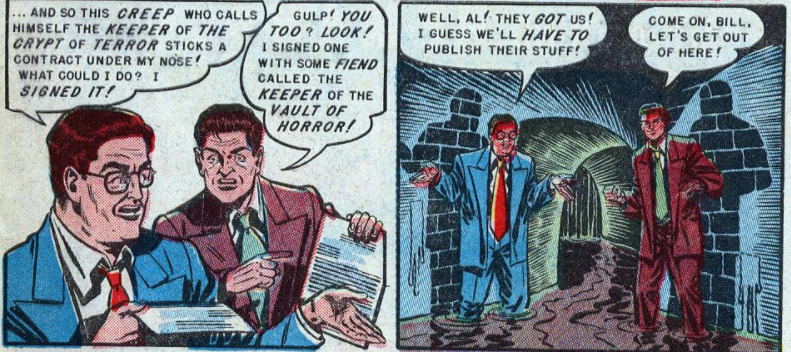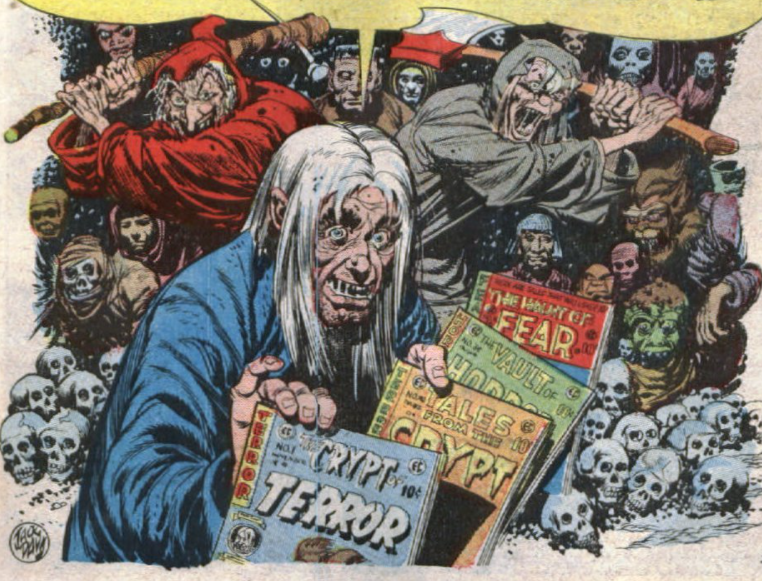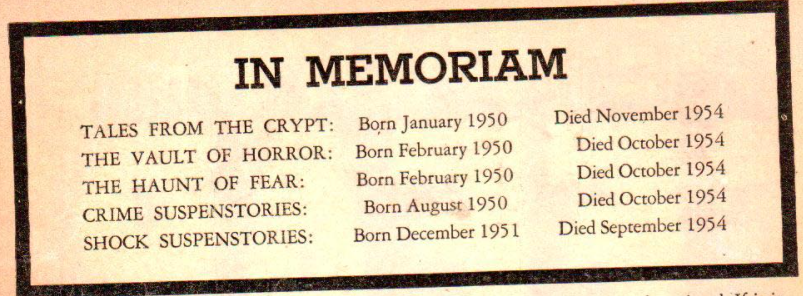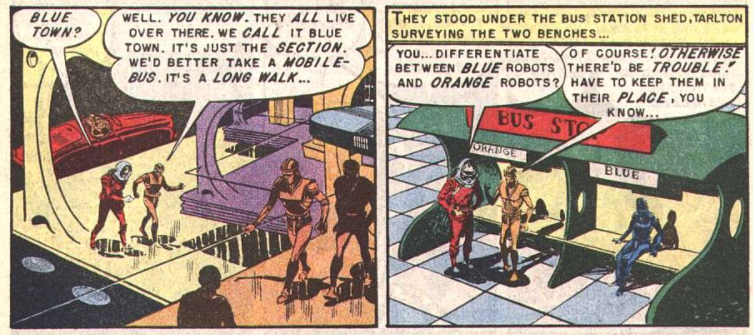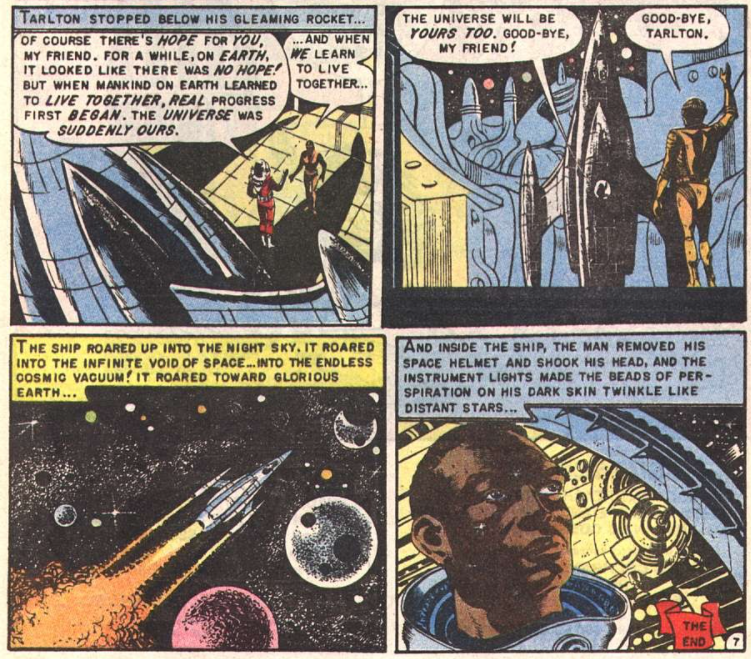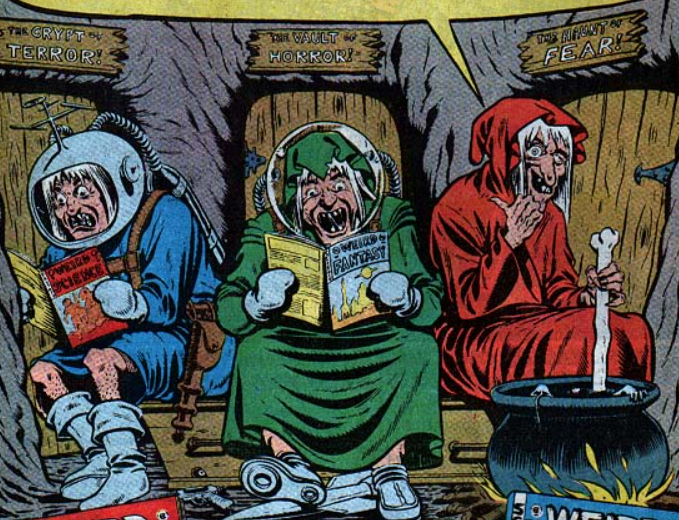048: The Burrow of Fright
I’ve always been fascinated by the darkness… both the darkness outside our windows after the sun has fallen and the deep shadows that lurk in everyone’s hearts. Throughout my life, this fascination has led me to explore the realms of horror in its many iterations. This Halloween I want to share with you a fond memory from my teenage years… my discovery of Tales From the Crypt!
The spooky and charismatic Crypt-Keeper. (Credit: EC Comics)
The year was 1993… Spider-Man was facing off against a still-villainous Venom in Amazing Spider-Man #375. Superman had come back to life with a special sealed white-bagged edition. The Simpsons hit the pages in their own line of comic books published by Bongo Comics. A thoughtful friend had given me a few choice comic books for my birthday and another friend had gotten me into Spawn and the Maxx. Curious about what was happening in the realm of comic books, I wandered into my local comic book shop. Around this time I had been voraciously reading the works of Stephen King and Clive Barker. I had just read King’s book Danse Macabre, which discussed the history of horror. I often stayed up all night on weekends with my friends enjoying rented B horror movies. Horror had always been an interest of mine, but at this stage in my life it was a passion.
So, of course, on my trip to the comic store, when I came across a reprinted copy of Tales From the Crypt, I snatched it up quickly. I recognized the comic from King’s mentions of it in Danse Macabre. Also I had caught a few episodes of the TV show. (But only a few. We didn’t have HBO back then.) Seeing the shlocky, attention-grabbing covers won me over, hearkening back to a time years before when I would stay up late on Saturday nights, all alone, the only light coming from the TV, darkness and silence surrounding me. Around 1988-1990, starting at midnight, the networks would play Freddy’s Nightmares, Monsters, and Tales From the Darkside, all in a row. I loved Saturday nights, staying up until 2 am (sometimes falling asleep in front of the TV) basking in tales of the things that lurked in the shadows. And years before that I would watch Twilight Zone and Night Gallery with my dad. (And in the process learning enough about story structure to guess the endings more often than not, impressing my dad.) Anthology horror was one of my favorite things… the stories would be different every time, and you never knew what you’d get. And here it was, in comic book form. I was ecstatic. I was even more delighted to learn that Tales From the Crypt was only one of three horror titles that EC Comics put out in the early to mid 50s.
On my next trip to the comic book store I found a couple copies each of Tales From the Crypt, The Vault of Horror, and Haunt of Fear. Sadly, the reprints had come out two years before and the store didn’t have many of them. I was still young and didn’t have the money for monthly trips to the comic store, so I was unable to fill out my collection. The issues I did get stuck with me, though, Inspiring my own writing and sparking my imagination to this day.
Sorry for the long introduction, but I wanted to set the stage properly for this one. These comics have meant a lot to me, and they deserve a proper context. In this post I’m going to share these old pulp comic stories with you all, along with some of the history and fate of EC Comics and some of their other works.
Ah, classic literature. (Credit: EC Comics)
The first issue I picked up is the screenshot above. It had a cover number of 6, but actually contained both Tales From the Crypt #42 from 1954 and Crime SuspenStories #27 from 1955. I’ll talk more about that issue later. The EC horror comics contained four comic stories and sometimes a one-page text story. The comic stories were around 6-8 pages in length and each were hosted by one of the three hosts, which were collectively known as the GhouLunatics.
A colorful cast. (Credit: EC Comics)
The first thing you’ll probably notice is that the Crypt-Keeper looks nothing like the puppet zombie corpse from the television series. He appears as a ghoulish old man with long white hair and bad teeth. He seems to take great glee in the suffering of the characters in the stories he hosts, introducing and closing them out with groan-inducing puns. Sometimes he also breaks in during the story to add his two cents. He wasn’t always like this, however. In the early issues he was a more sinister and dark figure. As the comics continued, he gradually evolved into a more comedic presence, lending comic relief to the stories he presided over. The same was true of the other two GhouLunatics, the Vault-Keeper and the Old Witch. The three would often reference each other and had a bit of a professional rivalry going, each thinking their title and stories were the best. Near the end of his run, the Vault-Keeper had a cohost, a mysterious, silent woman named Drusilla, who he said was his only companion in the Vault. They would also plug their own title in their coworker’s comic, letting the reader know which book would be at the newsstands next. All three would usually appear in each comic, with the host whose title it was leading two stories and the other two having one each.
I love puns. (Credit: EC Comics)
The horror stories ranged from the supernatural to the realistic. They could feature ghosts, witchcraft, supernatural monsters, and at times mortal monsters— people who were pushed too far and snapped. Some stories would be a bit more comedic in tone. Occasionally they would do what they called Grim Fairy Tales, putting more of a twisted fable slant to the story. There were also single page short text stories included in many issues. Many of the stories incorporated a twist ending or examples of poetic justice for the character’s sins. Having the hosts interject humor served to lighten the mood of the often dark stories. (EC rarely shied away from gore and violence.) Since the stories were told by characters we had come to know, they felt more personal. The GhouLunatics gave a good segue and endcap to the tales. There wasn’t much difference between the titles and the various stories regardless of the host who was telling them, but it was a good move to give the structure of the storytellers to the comics.
In my opinion, the stories were actually written very well. At times the stories were rushed due to the short amount of pages, but they did what they could with the space they had. The language used is descriptive and intelligent, the narratives well-constructed. They didn’t talk down to their readers but they also avoided pretention. It was a good balance. The stories were meant not only to frighten their readers, but also to entertain them, and so this was clearly always in mind as the stories were being written and illustrated.
The reprints I got (first from Gladstone Comics and then published independently by Russ Cochrane) included a bonus issue of one of the other EC Comics titles. Shock SuspenStories typically had stories about murderers, stalkers, people in peril from maniacs. Weird Science and Weird Fantasy dealt with aliens, space travel, robots… stories with more of a science fiction leaning.
I can’t imagine a cuter baby. (Credit: EC Comics)
On occasion, one of the GhouLunatics would actually make an appearance in a story. The image above is from Tales From the Crypt #33 in a story called “Lower Berth”. In this story we learn about a freak show that features, among others, a living mummy named Myrna and a two headed corpse named Enoch. The two ran away together to Enoch’s mother’s cave and had a baby before they were recaptured a year later. That baby grew up to be the Crypt-Keeper. We never got the Vault-Keeper’s origin (I’m sure they would have gotten around to it if they’d had the chance) but later we also learned where the Old Witch came from.
Okay, I take it back. She wins the cute baby award. (Credit: EC Comics)
In Haunt of Fear #14 in the story titled “A Little Stranger“ the story was told of a werewolf named Zorgo and a vampire named Elicia. They met arguing over a victim and ended up falling in love, however the lovers were only able to see each other every month during the full moon. They’re both hunted and killed by the terrified villagers and buried in a place called “The Devil’s Graveyard”. It’s here that they’re finally able to be married. (As… zombies… I guess?) A year later Elicia gives birth to an odd baby that grows up to be the Old Witch.
What a handsome woman. (Credit: EC Comics)
Some other stories featuring the GhouLunatics include “While the Cat’s Away” in the Vault of Horror #34. In this story, the Crypt-Keeper calls a travel agency to book a vacation and gives a pseudonym— T. Charles Kingman. (Initials T.C.K. or The Crypt-Keeper.) In this story we learn that the basement of the crypt contains rooms for zombies, werewolves, vampires, and mummies. We also learn the address: 711 Woods Road. In Haunt of Fear #17 “Horror Beneath the Streets” comic versions of real EC Comics creators Bill Gaines and Al Feldstein are chased into a sewer by the Old Witch and forced by C.K. and V.K. to sign contracts to publish their stories. The Old Witch gets her contract signed in exchange for allowing them to leave the sewer.
You could tell they really had fun drawing the GhouLunatics. (Credit: EC Comics)
To give you an idea of a typical issue, I’ll go over the stories in the first issue I got, Tales From the Crypt #42. This issue was originally published in 1954 and also included Crime SuspenStories #27 from 1955. (I didn’t know it then, but that was actually the final issue of Crime SuspenStories!) Both issues were reprinted by Gladstone Publishing in 1991 as Tales From the Crypt #6.
The first story was introduced by a gleeful Crypt-Keeper and was titled “Concerto For Violin and Werewolf”. A concert violinist named Sacha goes to a remote Transylvanian village to visit his elderly Maestro Vasile. His ulterior motive is to hunt a rumored local werewolf in the hope the fame will bring his concerts more attention. His attempts are thwarted when he learns that the entire village— including his old teacher— are all werewolves and Vasile switched his gun (and homemade silver bullets) for his expensive Stradivarius, which Vasile wanted for himself. He also wanted the other werewolves to save a soft part of Sacha for him… since he’s a toothless old werewolf.
My favorite part of this story was Sacha realizing there was more than one werewolf because he remembered a Tales From the Crypt story about a townful of vampires. EC was breaking the fourth wall way back in the 50s!
Oh, snap. (Credit: EC Comics)
The second story was hosted by the Vault-Keeper and was called “By Dawn’s Early Light”. At a funeral for a young woman named Joan, her husband-to-be Frank is distraught. He had been summoned back to Illinois from work in New York City by the terrible news that his fiancée had been killed. Earl, his best friend who works at the funeral home, had “made Joan pretty for him”. (Apparently she was a mess when they brought her in.) Frank goes for a drink with his friend Harry, who tells him the tale of Joan’s death. A vampire was rumored to be stalking the streets of the town. Harry, who had lost his own brother to the vampire, was out hunting it one night and came across the vampire attacking someone. He shot at the vampire and missed, but was too late to save its victim, who turned out to be Joan. She was unconscious, with two bitemarks on her neck. The other townspeople were summoned and they knew they had no choice but to put a stake through Joan’s heart before she turned. Harry was the one who had to drive it in.
After hearing this sad tale, Frank went on a hunt of his own, eventually coming across the vampire attacking Harry. He tracked the vampire to the funeral home. In the cellar, he ambushed his friend Earl and tied him up, putting him in a coffin that was lined with dirt. (Which proved the vampire used the cellar as his lair.) Although Earl insisted he was not the vampire, Frank didn’t believe him. He was ready to stake him if he fell asleep as soon as the sun came up. The problem was there were no windows in the cellar of the funeral home. Earl told him to check the calendar for the time that dawn would occur and check it against his watch. The time came and went, but Earl didn’t fall asleep. Admitting he was wrong, Frank untied Earl, who grinned evilly and told him that since he’d just flown in from New York, he hadn’t thought to set his watch back an hour. Earl pounces on Frank and the story ends there.
Tricky vampire. (Credit: EC Comics)
The third story was “The Bath”. This one was presided over by the Crypt-Keeper but as sometimes was the custom with the third story in an issue, he has no commentary about it. This is the story about a cruel, greedy man named Pedro Tobosa and his berated man-servant Raoul. Pedro is verbally abusive towards his servant and physically abusive to the natives he forces to work in his silver mine. He tricked them into servitude promising better conditions than he was willing to give them. Pedro was also a germaphobe and obsessed with bathing and cleanliness. The last straw came when he worked a young boy to death and then shot his upset parents, gunning them down in cold blood. He left the three corpses to rot in the sun as a message to the other workers. Secretly Raoul filled his master’s bath with deadly piranhas (claiming they were fancy new bath salts) and watched as they ate him alive. It turns out the boy and his parents were Raoul’s family.
A relaxing bath. (Credit: EC Comics)
The last story was hosted by the Old Witch and was called “Hoodwinked”. A man named Leon comes home to find his living room trashed. His brother Chet is there and there is a body in his bathroom. Leon recounts their life together from their mother’s untimely death due to illness. On her deathbed she made Leon promise to always take care of his younger brother, no matter what. She died before hearing Leon give his word, but he felt bound to the promise regardless. From then on, Leon worked overtime to support his brother, buying him first a bike, then a car. Leon gave his brother everything, but Chet always wanted more. While Chet was away at college (paid for by his older brother, of course) Leon met Claire and fell in love. She’d broken up with her boyfriend because he’d gotten fresh with her. Chet came back for a visit and spent the money Leon had been saving for a wedding on a television set, which he then sold.
After three years of putting off the wedding, Chet dropped out of college. And instead of giving the tuition back to his brother, Chet spent it on a new sports car. He’d also sold his old car, which Leon still owed $1000 on. And Chet still wanted more… a radio, a horn, and then a silver hood ornament. That was when Claire gave her ultimatum. She had been patient long enough and was tired of Leon caving to his brother’s demands constantly and suffering for it. If Leon bought the hood ornament, she would leave him. For the first time in his life, Leon told his brother no.
The next day, drunk and upset, Chet forced himself on Claire, taking her virtue. Later that day, unable to live with the trauma, Claire killed herself by drinking iodine in the bathroom. And that’s where we came in, with Leon arriving back home, learning what had happened. Chet apologized, saying he hadn’t meant for it to happen and that he’d go back to college. Leon raged, saying that he’d given his brother everything. But had he? No, he’d refused to give him that hood ornament. And I’m sure you can see where this is going…
Twist endings were the norm in these comics. (Credit: EC Comics)
The reprints not only allowed easy access to the old horror comics, but included a second issue of one of EC’s other titles: Crime SuspenStories, Shock SuspenStories, Weird Fantasy, Weird Science-Fantasy, and more. The rest of this particular issue was devoted to Crime SuspenStories. These were all suspenseful stories about people in danger, psychotic maniacs, things like that. They were entertaining, although they did lack the gleeful gruesomeness of the Crypt-Keeper and friend’s tales.
Possibly one of the greatest comic book covers ever. (Credit: EC Comics)
A very notorious story was “Out Of His Head” from The Vault of Horror #32. The cover was censored by the EC editors before release, but in reprints the art was restored to its original form. (In the censored version the cleaver is replaced by a small lens flare.) The story itself took some clear cues from Edgar Allen Poe’s The Telltale Heart, but with the usual EC style and gruesome visuals.
In this story, while on a hunting trip, a man named Alex kills his law partner Stanley and returns home, leaving him lying in the woods with a cleaver in his head. The reasons for this aren’t given— all the caption says is “Stanley would be dead and Alex’s problem solved'.”— but we can assume that with Stanley out of the picture, Alex gets the firm? Whatever the reason, the point is that from then on Alex is haunted by the zombie-like apparition of his dead partner, leering dumbly at him, still with the cleaver buried in his skull. Nothing Alex does will rid him of the gruesome vision, except keeping his eyes closed. But when he has his eyes closed, he can’t drink and smoke. (No, really, that was his biggest concern.)
This panel is hilarious to me. (Credit: EC Comics)
Finally he gets the idea to poke his own eyes out with an ice pick. Surprisingly they do this between panels and spare us the image. Maybe they felt they’d already gone far enough with the visuals?
He’s overreacting. Stanley just wants to show him his new cleaver. (Credit: EC Comics)
Unfortunately Alex doesn’t seem to be good at self-mutilation because he soon awakens in a hospital, his vision restored. (And no scars? You’re terrible at this Alex. Sheesh.) Mistaking the glow of the doctor’s head reflector for Stanley’s meat cleaver, Alex screams and throws himself out of the window, ending his life and the story.
There’s a lot going on in this cover. (Credit: EC Comics)
Since these stories were written in the 50s, you’re bound to run into some dated sensibilities. One of the stories I revisited during my preparations for this post was a good example of this. It was a story also from The Vault of Horror #32 called “The Ample Sample”. Irwin’s wife Hannah becomes addicted to chocolates and spends all his money on it, gaining a lot of weight. (There’s a bit of fat shaming in this story, but not played for comedic effect, at least.) Her favorites are the “Whiteman Samplers” that include the description on the lid of what each chocolate contained. Irwin is upset and argues with her, since he only makes $30 a week. (Yikes.) He couldn’t afford clothes or necessities due to her vice. Anyway, long story short she spent all of his savings that he was hiding away on more boxes of chocolate and he finally snaps. He chops her up and puts her in a home-made sampler box.
Okay, this is kinda creative, I’ll give them that. (Credit: EC Comics)
So yeah, although the ending is pretty amusing I get the feeling that was all they really had and they worked backwards from there. The depiction of Hannah as a greedy, irresponsible mooch (“I only get three dollars a week for carfare and lunch money.“ “Eat smaller lunches.”) is insulting. Irwin’s sudden overreaction and the preparation his revenge would have taken— carefully constructing the box and labeling all the parts shows that he has control of his faculties, so this probably wouldn’t be a lapse of sanity sort of thing— is set up by the story but happens so suddenly that it’s jarring. Since they work with such short page runs, it becomes necessary to occasionally resort to making caricatures of the characters and abbreviating the plot progression. This causes the stories to suffer at times. So yeah, they weren’t all good.
Unfortunately, I didn’t have the time to read as many of the issues as I wanted, but I recall stories about zombies, ghosts, curses, and more. There was a great variety to the stories, and you never knew what you were getting from issue to issue. Horror anthologies can be good or bad, depending on the quality of the stories they have and how well they tell those stories. Some tales were slow, some dry, some predictable. But if you didn’t like one of the stories, just keep reading… the next one would invariably be better. It was a good format to experiment and explore the genre. And those experiments paid off, with the horror comics selling quite well and inspiring many imitators from other comics companies.
Is this how the comic industry works? (Credit: EC Comics)
EC Comics (which stood for Entertaining Comics) didn’t just do horror stories. As I mentioned earlier, they also had crime, war, and science fiction titles. Although they were proud of their sci fi stories, the truth was they just didn’t sell as well as the horror titles. After numerous retoolings, the sci fi comics were cancelled in favor of horror. They did adaptations of Ray Bradbury stories and the stories of Eando Binder. (Binder’s robot character Adam Link actually inspired Isaac Asimov to start writing robot-themed stories.) As for Bradbury, that started in an unexpected way. They actually plagiarized two of his stories, combining them into a new story for one of their comics. Bradbury wrote a letter complimenting the story and stating that he’d somehow never received payment for it. EC sent a check and a formal request to do official adaptations of his stories, which he granted them permission to do. They went on to do at least two dozen adaptations of his stories.
A brief history: EC Comics during this period was run by William Gaines, who inherited the company from his father Maxwell Gaines after he perished in a boating accident. The Senior Gaines actually helped to form DC and branched off to create his own imprint, which he named Educational Comics. He specialized in children’s fare and bible stories. When Bill took over, he gradually rebranded them to Entertaining Comics and started publishing more mature stories. His main editors were Al Feldstein and Harvey Kurtzman, who also wrote and drew portions of the comics. Kurtzman created Mad Magazine as a side project, and that eventually became one of the things the company was best known for.
I love this picture. This would make a great poster. (Credit: EC Comics)
One interesting aspect to EC comics is that the numbering is very strange. There was no Tales From the Crypt Issue 1. The first Crypt of Terror stories were featured in the comic Crime Patrol, included as an experiment. They noticed the sales were going up and they got letters requesting more horror content, so they changed the title and dedicated the comic solely to horror tales.
This was a strange quirk of Golden Age comics. See, back then comics were sent through the U.S. Postal Service using what was called a Second Class Entry. To publish and distribute a new title they would have to pay a fee to start that entry. Instead, in a cost-saving move, publishers would simply change the title of the book and leave the numbering the same. So, for instance, Crime Patrol became the Crypt of Terror and finally Tales From the Crypt. The same thing happened with Vault of Horror and Haunt of Fear.
This wasn’t just done with EC Comics. Marvel, as an example, retitled Journey Into Mystery to The Mighty Thor with issue 126. Tales of Suspense became Captain America with issue 100. And Strange Tales became Doctor Strange with issue 169. There are more examples and it was an industry-wide practice. This may have made things easier for the publishers back then, but this creates a terrible effect for collectors and the legacy of the comic series, because really the comic book had nothing to do with the titular character up to a certain point where popularity dictated a title change was necessary. This can create a lot of confusion.(Can you really celebrate Captain America’s 500th issue if 99 of those weren’t his?)
So there you have it— a mystery solved. I always wondered why they did those weird title changes. And this explains how some of my childhood comic books like Disney and Bugs Bunny were in the 300 and 400 range for issues. That always seemed strange to me. (Like how many adventures could Uncle Scrooge really have with the Beagle Boys or Porky Pig with Bugs Bunny? Apparently over 90, if the issue numbers could be believed!) Now I know.
I actually learned a lot in my research for this post. I didn’t know EC did Mad Magazine. (Or maybe I forgot.) I also read in an interview that Gaines would take a bunch of Dexadrine and stay up all night reading and scribbling ideas on scraps of paper. He called these “springboards” and he would show up to work the next morning and pitch the springboards to the editors and artists. So yeah, at least in part EC Comics was the result of drugs and sleep deprivation.
So sad. (Credit: EC Comics)
Anyway, Tales From the Crypt actually started with issue 20. The series started its life as International Comics, then International Crime Patrol, Crime Patrol, and then The Crypt of Terror for issues 17-19. On issue 20 it was finally renamed to Tales From the Crypt and lasted until issue 46 for a total of 30 issues. It ran bi-monthly from 1950 to 1955.
War Against Crime was renamed to The Vault of Horror with issue 12. It ended with issue 40 after 29 issues. The Haunt of Fear was super confusing. It started as a comic named Fat & Slat, then Gunslinger. It changed to The Haunt of Fear with issue 15, but then issue 18 was renumbered to 4, making it very convoluted. To make it worse, Two-Fisted Tales took over Haunt’s numbering, starting with issue 18. So essentially Haunt had two issues each of 15, 16, and 17. The Haunt of Fear ended with issue 28.
In the final issue of Tales From the Crypt, they announced that they would be adding a fourth title to their horror line, reviving the original title of The Crypt of Terror. It would, of course, be hosted by the Crypt-Keeper with the help of the other two GhouLunatics. Interestingly enough, the final issue of Haunt of Fear has C.K. saying that he’ll see us in the second issue of Crypt of Terror, but looking around, there was never a first. After a little digging I learned that Tales From the Crypt issue 46 is actually the Crypt of Terror #1. They’d finished only one issue and didn’t want it to go to waste. All the comics were gone after this final issue. There was a reason for this…
For several issues leading up to the end there were full page editorials printed in the comics titled “A Call To Action”, imploring readers to write to Congress. And then in The Haunt of Fear #28 another full page editorial announced that EC was cancelling all of its crime and horror titles. So why would they cancel their most popular comic books at the height of their popularity? To answer that we need to look at the social and political landscape of the time.
The 50s were a time of great repression and a strong emphasis on family values and Christian morals. From the late 40s on, concerned parent’s groups were petitioning comic publishers to monitor their content, to make it safe and proper. They were afraid that comic books were warping their children, making them illiterate and degenerates. The early attempts at this self-regulation failed. In 1954 a psychiatrist named Dr. Frederic Wertham published a soon-to-be notorious book titled “The Seduction of the Innocent”. This book warned baselessly that comic books contributed to juvenile delinquency. This book caused enough panic in parents groups that in 1954 Congress created a Subcommittee on Juvenile Delinquency and called a hearing on the matter. The hearing and Wertham’s book used EC Comics along with many other publishers as examples of the “filth” that was being peddled to impressionable children. An infamous image from these proceedings was the eye injury panel from True Crime Comics #2, drawn by Jack Cole.
To prevent outside restrictions, comics publishers willingly formed the Comics Magazine Associate of America and created the Comics Code Authority, a code that rated the contents of comic books. In order to be published and widely distributed, each comic book would have to pass inspection and adhere to the code. Many of the restrictions set down by the CCA seemed to deliberately attack EC Comics. The code forbid titles with the words “crime”, “horror”, or “terror”. It also banned depictions of vampires, werewolves, zombies, and other unsavory characters. Newsstands were refusing to carry EC Comics without the CCA stamp on them, and so Gaines decided to cancel the horror and suspense comics rather than alter their proven formula. They attempted a wave of new comic books they called their “New Direction” and even started submitting their new comics to the CCA, but they could not attain the sales they had before. EC decided to stop publishing comic books altogether and focused on Mad, which had recently been changed to a larger magazine format. Magazines were not adhered to the CCA, so they had none of the same problems.
Between 2001 and 2011 one by one the publishers quietly dropped the code, and it’s currently obsolete. Still, the damage had already long ago been done.
From “Hate!”, Shock SuspenStories #5 (Credit: EC Comics)
This talk of censorship and content brings me to another topic I want to discuss. You may be wondering the same thing I was around this time in my research. These comics were written by white guys in the 50s… so when do they get super racist? (Sadly there are many examples of racism in Golden Age comics.) Well, thankfully they don’t. Quite the opposite, in fact. You see, EC didn’t just do horror and crime stories, they also got political and social-minded at times.
They made statements about racial bigotry, anti-Semitism, interracial relationships, police corruption. The screenshot above is from a story where a bigot is persecuting his new Jewish neighbors. He learns that he was adopted and is actually Jewish himself. His friends quickly turn on him and as he has a crisis of self-identity, they beat him mercilessly.
The story I want to talk about now is a good example of this kind of social-minded story. This story was called “Judgment Day” and was reprinted in 1955 in Incredible Science Fiction #33. (Originally published in 1953 in Weird Fantasy #18.) This story was a last-minute replacement for a story named “An Eye For An Eye”, which the Comics Code Authority said violated the rules. Upon reviewing Judgment Day, they stated this story also violated the rules unless they changed the astronaut main character from black to white. But his race was the entire point of the story, so they refused to change it.
The story involves an astronaut named Tarlton who lands on a planet populated by robots in order to determine if they should be included in the Galactic Republic. His guide assures them they’re ready for this honor and have built a free enterprise society. Tarlton soon learns that the robots have divided themselves into races: orange robots and blue robots. They are built the same and are physically identical except for the color of their outside sheathing, yet the blue robots are oppressed, not given the same opportunities as the orange robots.
Robot racism. (Credit: EC Comics)
The blue robots are forced to live in another area of the city named “blue town”, given separate seating, separate charging stations. They are kept in poverty, and forced to work menial jobs. After assembly, each robot is educated, and then made to work on the assembly line for a time. After that, the orange robots are given their choice of career. The blue robots are not given this chance. When asked why things are this way, the guide has no answer, just that it’s always been like this.
Social commentary. (Credit: EC Comics)
It couldn’t possibly be his fault! He didn’t do this, he’s just going along with it! One robot can’t change anything. Tarlton informs his guide that he cannot allow the robot society into the Galactic Republic until they can get over their bigotry. In the last panel he removes his helmet to reveal he’s black.
Very well done. (Credit: EC Comics)
Not too sweeping by today’s standards, but if you keep in mind this was originally published in 1953, it becomes impressive. And the fact that the Comics Code Authority objected to its reprinting without giving a good reason shows that either the whole idea of the comic self-regulatory group was flawed from the start or that EC Comics was being targeted to prevent future embarrassment and controversy.
There are more examples of this type of social commentary story in EC’s comics. Their underlying message: hate is learned and we can grow beyond it. These stories pushed the boundaries of the established norms of America in the 50s, striving to change the reader’s minds, alter their deeply-engrained biases. If racism is learned, they speculated, we could learn acceptance instead. In this way EC’s detractors were right. The comic books were trying to corrupt their youth… but only from their biased viewpoint. No, they were trying to make positive change.
There’s one last story I want to bring up because it ties into what I’ve been saying, and also because it’s always stuck with me. It’s called “The Reformers” and it was published in Weird Science #20 in 1953. A group of space travelers arrive on a planet, their mission to reform the people and eliminate the evils of their society. (They’d been to Earth just before this.) They are greeted by an old man named Peter who insists there are no evils on their world. They ask to see his leader and he explains that his leader doesn’t accept visitors, and he will show them around so they can see there is nothing to reform. There is no crime or vandals on their planet. No inequality or discontent. Everything the people need are equally distributed, and there isn’t even a need to work. They are moral and not self-indulgent. They can eat or drink whatever they want— even alcohol— because there is no excess. There aren’t even any restrictions on clothing…
I really only included this screenshot to show you this woman’s scandalous outfit. My god, you can see her knee! (Credit: EC Comics)
Peter has two good lines here: “Where there is love and beauty, there is no temptation.” and “If one is evil, one sees evil, even in beauty!“
What shocks the visitors the most is the uncensored literature. People can read about crime without wanting to commit it? Unthinkable! They even visit a newsstand where shocking comic books are sold. (One looks like Weird Science.)
Hehe. (Credit: EC Comics)
Desperate, the men decide since they could find nothing to reform, they must create the evils they seek— crime, murder, drunkenness, promiscuity. But before they can put their insidious plan into motion, they’re contacted by their chief Lucifer. He orders them to leave because there will be no reforming that planet. They’ve landed on heaven!
So yeah, clearly this was a statement against Wertham and the parents groups. Comics books weren’t the villains… the villains were those creating evil where there was none. They wanted a scapegoat to prevent themselves from having to make any real change.
I have to wonder what would have become of the EC horror comics had it not been for the comics code and all the controversy. They were very successful books and showed no signs of slowing. The fact that they were expanding to a fourth title shows how well they were doing. Would they have eventually added a fifth title and a fourth GhouLunatic? Would Drusilla have ever spoken? Would we have seen the Vault-Keeper as a baby? We will never know, because the EC horror line was cut down in its prime. Of course these comics were born at the tail end of the Golden Age of Comics, when readers were tired of superheroes… superheroes made a comeback in a big way in the Silver Age, so eventually these comics would have likely died out as interests changed. (Or been renamed to Heroic Comics? That seems plausible.) But the fact that they were snuffed out before they had a chance to end naturally will always be sad to me. At least we got the issues we got.
He has great screen presence. (Credit: HBO, Warner Bros)
The EC comic books had a very popular adaptation in the Tales From the Crypt television series. This series ran on HBO from 1989 to 1996 for a total of 93 episodes. Many of the stories depicted in this series were adapted from the various EC series, including their crime comics. (In fact, three of the episodes were repackaged from a failed pilot for a Two-Fisted Tales spinoff series.) The series, being aired on a cable channel, included explicit content such as blood, sex, and nudity.
The Cryptkeeper (no hyphen for some reason) on the show looked nothing like the one in the comics. I’m assuming they just wanted to up the camp and make someone a tad more gruesome and marketable than the ghoulish old man from the original. (Or maybe he is the same guy, just older now and dead?) I don’t know how accurate this is, but I always suspected that they combined the three mascots into one for this new character. They used the Crypt-Keeper’s name and fondness for puns, the Vault-Keeper’s cloak, and the Old Witch’s good looks.
The series had two movies. Tales From the Crypt Presents: Demon Knight (1995) and Tales From the Crypt Presents: Bordello of Blood (1996). I saw both in the theaters… the second one was pretty bad. Various movies were pitched to be the third film in the trilogy, but a third official movie was never made. In 2002 a movie called Ritual was intended to be the third film, and actually has a Cryptkeeper intro, but it was removed until the DVD release.
Following the end of the series, a spinoff called Perversions of Science aired briefly in 1997, ending after only 10 episodes. This show was hosted by a female robot (complete with metal boobs) named Chrome. The content of these episodes were also adapted from EC Comics, this time their science fiction titles.
Tales From the Crypt… for kids! (Credit: Nelvana)
Surprisingly enough, there was a spinoff of the series aimed at children in 1993. Tales From the Cryptkeeper aired on ABC for two seasons and 26 episodes. (I honestly forgot this show existed until I was researching this post!) It was revived on CBS in 1999 for an additional 13 episodes. In season 2 they brought in the Vault-Keeper and the Old Witch, who schemed to take over C.K.’s show since they didn’t have their own shows.
I also learned that there was a British film adaption of the comic in 1972. (I need to find that movie!) Not content to keep to print and screen, the Cryptkeeper put out out a Christmas album and a heavy metal album. There was even a short-lived game show called Secrets of the Cryptkeeper's Haunted House and a radio series.
I need to see this movie again. (Credit: George A Romero, Stephen King, Warner Bros)
Not only was there a popular TV series, movies, and a cartoon, but these comics were also the main inspiration for Stephen King’s Creepshow, which was a great movie (and decent sequel) and now a full TV series. (I haven’t seen it yet, but it looks good.) Two comics companies have attempted to revive the comic series over the years, but those attempts were short lived. There were also a few attempts at rebooting the TV series (one with M. Night Shyamalan attached), but those have all fallen flat so far.
EC Comics has periodically rereleased the comic books with enhanced coloring, both in print and digitally. As of right now, not all the comics are available digitally. I’ve read that the TV series isn’t currently streaming due to complicated licensing issues. I’m not sure if those extend to the comics as well. But I think it would be worth some enterprising comics team reviving the properties, making a new generation of pulp horror anthologies. Hopefully they would have better luck than the ones who have tried it so far. As long as it’s done in the same spirit, it’s worth a try.
Cute. (Credit: EC Comics)
So that’s a crash course in EC and their historical horror line. Currently I have 15 issues altogether across the three series. Someday I will collect the rest. I hesitate to get them digitally until all the volumes of the EC Archives are available on Kindle or Comixology. I’ll keep checking back and may end up splurging on hardcovers or something. After doing this post, I’m dying to read more. (*Insert mad cackling here*)
These comics represent a time of great discovery for me— I was exploring the arenas of horror and sci fi, getting into X-Files and Weekly World News, reveling schlocky horror movies, and all sorts of fun stuff. It’s a fascination that’s never fully left me, although I don’t have as much time to devote to it as I used to have. These comics also represent cultural history to me… the turn towards shocking, attention-grabbing covers and content that pushed the rigid boundaries of society and ended up changing the comic industry for decades to follow. In researching and compiling this post, I not only rediscovered my love for the classic horror of EC Comics, but I also learned a lot that I didn’t know before. I started off intending to just talk about Tales From the Crypt, but it sort of ballooned from there and I went with it. I hope you all learned some things too.
EC Comics was ahead of its time in many ways and created some very enduring and endearing characters and stories. I’ve only just barely scratched the surface in this overview. The old EC comics are a treasure trove of quick, entertaining tales running the gamut of horror, science fiction, suspense, and crime drama. If any of what I’ve said in this post seems interesting to you, I recommend looking up some of their comics and giving them a read. You never know, you may just find your new favorite thing!
It seems Halloween is a time of nostalgia for me… first Silent Hill, then Nightmare on Elm Street, now this. Who knows what I’ll dredge up next! It was ghoulish fun revisiting these old, pulpy comics and I hope you all had a howl of a time travelling down memory lane with me. So with that, another Halloween in the Burrow of Fright is dead and buried. Until next time, take scare. I bid you good fright! Heh heh.
“Tha— tha— that’s all folks!” (Credit: EC Comics)





